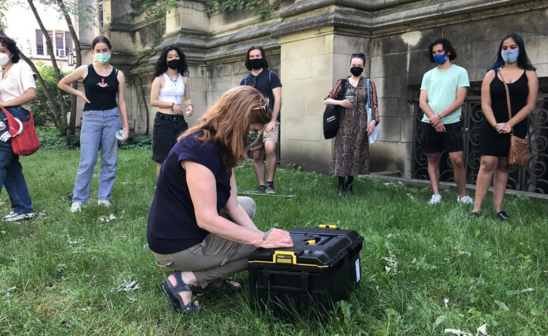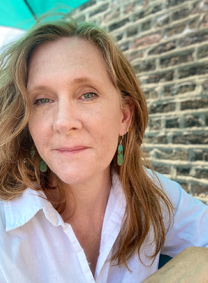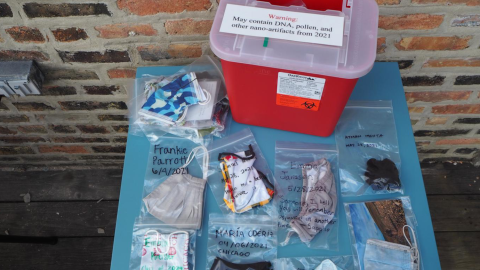In time capsule, UChicago students send COVID-19 artifacts 100 years into the future

This story was originally published by UChicago News. Read the article on their site here.
Anthropology class explores ‘how materials communicate’ through time
Vaccination efforts have begun to curb COVID-19 outbreaks across the United States. But even after the public health threat recedes, how do we reckon with the trauma of the pandemic, finding hope after a tragedy? And how will we tell the story of this moment to those who come after us?
During Spring Quarter, a UChicago undergraduate class spent weeks filling a time capsule with objects representing their experience of the pandemic—including photo reels and masks—for students 100 years in the future.
Sealed with instructions, the time capsule has been deposited at an undisclosed location on campus. Instructions on how to find the capsule and unlock it are under seal at the University Archives at Regenstein Library until 2121, to be part of UChicago’s annual Scav Hunt. To help ensure the objects survive a century in storage, they have each been sealed inside artifact bags and placed inside a sturdy lock box.
The capsule came together as part of the “Anthropology of the Future” course taught by Prof. Shannon Lee Dawdy. A leading anthropologist and archaeologist who focuses on landscapes and material objects, Dawdy wanted to encourage students to think critically about anthropological contexts, and to push back against the idea that the future is inherently negative.
“Hope—or pessimism—affects your experience in the present as an orientation toward the future,” she said.
Dawdy hopes to provide a counterweight to what she sees as a “pervasive cultural pessimism” in academic circles, especially on issues like democracy and climate change. “When you think you already know everything that’s wrong with the world—and that nothing will work to fix it—then big solutions are framed as naïve and utopian,” she said. That pessimism, Dawdy added, can become psychologically harmful and intellectually limiting.
When she taught this course before the pandemic, Dawdy discussed cultural taboos against optimism, and asked students to think more expansively about possible futures. This time, amid a real dystopian experience, her class explored how to process disaster while still conceiving of a post-pandemic world.
The class was taught in-person with proper safety protocols, which gave the students the opportunity to make non-virtual connections with one another—creating a unique “energy” around a common project that brought them together, according to some.
Masks and personal notes prepared by students as mementos of the COVID-19 pandemic are prepared before being deposited in the time capsule.
Photo courtesy of Shannon Lee Dawdy
“It was meaningful to actually be in person for my final class of my second year,” said Ian Resnick, a rising third year. “It was emotional. To be physically present and acknowledge both the danger of this time and the collective struggle—while also creating this project together—was an opportunity for hope.”
As an anthropologist, Dawdy has worked with communities in New Orleans, where she witnessed firsthand the impact of Hurricane Katrina, and the slow recovery that followed, “in an apocalyptic landscape—a place I loved that was vacated.”
In conceiving of the COVID-19 time capsule project, Dawdy sought to help students create room for hope while reckoning with a difficult reality, and to create a bridge between students and future generations. As an expert on archival practices, she decided that a time capsule would prompt students to imagine a future 100 years from now—beyond themselves—while preserving ephemeral artifacts of the pandemic.
“As an archaeologist, I’m always interested in how materials communicate across long time spans,” Dawdy said. Unlike an archaeological site, she noted, a time capsule is an intentional archive. As such, it is both public-facing—we can’t know who will open it—but private as well: Those who made it are the only ones who will know its full contents for the next 100 years.
“There is an interesting gray area between communicating to future generations, and communicating to non-human entities, like spirits or gods,” she said.
“To be physically present and acknowledge both the danger of this time and the collective struggle—while also creating this project together—was an opportunity for hope.”
The students in the class were tasked with a variety of specific parts of the project. Some worked on choosing the proper container—one that would be appropriately resilient—while others worked on a video trailer explaining aspects of their approach to the project, including the choice to include viewfinders and photo reels as objects uniquely suited to communicating a “personal perspective that might not be easy to find in 100 years.”
“For us, [viewfinders] evoke the feeling of being suspended in time that has accompanied the restructuring of our reality during the pandemic,” the students said in the video narration. Because of the format, they added, future students will have to “look into a machine” to interact with their message, just as they have had to for the past year. Each student also had the opportunity to include a personal note or memento, as well as a mask as a physical token.
For fourth-year Griffin Badalamente, the experience was a capstone both to his undergraduate education and a socially distanced year in Chicago. As he finished his thesis, he said, having an in-person class centered around the creation of a tangible, physical product was “an important opportunity to step outside my own headspace, work and computer screen.”
For the time capsule, Badalamente’s group made an illustrated glossary of COVID-19-related terms: words like “Zoom fatigue” and “travel ban” that impacted the student experience. They decided to also include illustrations as part of the glossary, as phrases that refer to specific circumstances and technology can quickly become anachronistic.
Video courtesy of Talia Ratnavale. Narration by Mohini Kumar, script by Maria Oderiz.
Another group of students collected screenshots of actual communications between people in the earliest days of the pandemic in the United States. Texts and instant messages between families and friends captured the panic, denial, anger and dark humor that characterized the first lockdowns in a personal way that government records and newspaper articles could not.
“We wanted to capture that feeling: a slow-burning apocalypse that was often, for us, out of sight,” said Resnick. “To interface with it while social distancing, we had to look at our screens.”
First-year Emma Janssen’s group focused on the notion of hope, while creating a piece that nodded to ideas of intimacy and nostalgia: a scrapbook that included graduation photos, recipes for baked goods that friends had left on each other’s doorsteps, and images of other things that symbolized hope and connection.
Over the past year, Janssen and her fellow first-years, she said, “worked together to find ways of being OK.” She was surprised at their resilience, and is excited to return to campus after a year of physical separation.
“Creating community and friendship is going to be really important,” Janssen said. “I’m almost nervous to see what it’s like to return … but I think it’s going to be really good. I think it’ll work out.”


